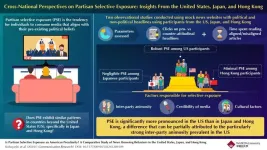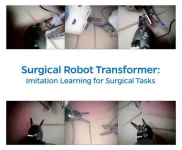(Press-News.org) A new study from Tulane University finds that historical race-based lending practices are still impacting health today, linking these discriminatory policies to delays in effective HIV treatment within affected neighborhoods.
The lending practice, called redlining, was abolished in 1968. Yet, those living in once historically redlined neighborhoods experience 15% longer delays in achieving viral suppression of HIV compared to those in non-redlined areas, according to the study published in JAMA Internal Medicine.
The disparity can impact both individual health outcomes and public health efforts to curb the spread of HIV, said senior author Scott Batey, PhD, professor at Tulane’s School of Social Work.
“HIV is, in many ways, a disease of poverty, and this shows how discriminatory practices that limited economic opportunities for previous generations can have a cascading effect upon the neighborhoods in which we live today,” Batey said.
Redlining involves denying services to residents in certain areas based on their race or ethnicity. The term comes from the practice of mortgage lenders drawing red lines on maps to indicate areas where they wouldn't make loans. The divestment from those neighborhoods created long-term gaps in health care access, education and household income that affected residents for decades.
The study, which is the first to examine the impact of redlining on HIV treatment, sheds light on how historical discrimination continues to affect modern day health outcomes. It was conducted in collaboration with Louisiana Department of Health and the University of Alabama at Birmingham.
Researchers examined 1,132 New Orleans residents newly diagnosed with HIV between 2011 and 2019 and found that, post-diagnosis, those living in once-redlined neighborhoods were estimated to achieve viral suppression of HIV almost a month slower than those living in non-historically redlined neighborhoods (193 days compared to 164).
Once diagnosed, HIV can be treated in as little as a month, and treatment is as simple as taking one pill a day. The longer the time between diagnosis and treatment, however, the higher the chances of HIV spreading.
In the case of one resident of a redlined neighborhood, there was a 4-year gap between diagnosis and suppression.
“The reasons some lag behind in treatment are obviously much more complex, from stigma to denial,” Batey said. “However, this paper shows us that environment does play a factor. Place matters and we are unable to escape historical implications and characteristics of the neighborhoods in which we live.”
Of the residents included in the study, 62% live in previously redlined neighborhoods. The majority were men ages 25-44, and despite New Orleans’s population being majority Black, the study found more Black individuals in redlined neighborhoods than non-redlined.
Notably, the delay in treatment did not change based on whether a neighborhood was experiencing gentrification.
Previous studies have linked living in a historically redlined neighborhood to higher risks of heart failure, obesity, high blood pressure and other conditions that increase risk of an early death.
While the study only included New Orleans residents, the findings are significant for cities across the Deep South, where redlining was historically prevalent and where more than 50% of the new HIV cases are currently being reported.
Batey said that by better understanding which areas are seeing longer delays in HIV treatment outcomes, health care workers can work to more effectively promote and deliver HIV treatment – and hopefully curb the spread of the disease.
“If we can make services more accessible and get people virally suppressed sooner, I think the impact on the HIV epidemic can be quite significant,” Batey said. “More education, on-site testing, telehealth appointments, those kinds of things can happen at grassroots level in all communities and begin to help people to start on equitable ground.”
END
New study links historical redlining to delays in HIV treatment
2024-11-11
ELSE PRESS RELEASES FROM THIS DATE:
Understanding causes of echo chambers: Political news selective exposure across countries
2024-11-11
In our digital age, with easy access to a vast array of information, one would think that readers would naturally be exposed to a wide range of perspectives. However, the opposite seems to be happening, especially in countries like the United States (US), where people often seek out news that reinforces their existing beliefs and avoid content that challenges them. This tendency, known as partisan selective exposure, has been linked to increasing divides and tensions between different ideological groups. But is ...
New study reveals unique adaptations of jaw function and tooth wear in hypercarnivores
2024-11-11
A new study led by Dr. Jack Tseng and published in PeerJ Life & Environment has shed light on the intricate relationship between tooth wear and jaw mechanics in highly carnivorous mammals, known as hypercarnivores. As mammalian teeth do not regenerate, these animals often face declining bite efficiency as their teeth wear down over time. This research explores how different hypercarnivorous species, including scavengers, meat specialists, and bone-cracking predators, adapt biomechanically and possibly behaviorally to manage the challenges posed by tooth wear.
The ...
Robot that watched surgery videos performs with skill of human doctor
2024-11-11
A robot, trained for the first time by watching videos of seasoned surgeons, executed the same surgical procedures as skillfully as the human doctors.
The successful use of imitation learning to train surgical robots eliminates the need to program robots with each individual move required during a medical procedure and brings the field of robotic surgery closer to true autonomy, where robots could perform complex surgeries without human help.
“It’s really magical to have this model and all we do is feed it camera input and it can predict the robotic ...
“Emotional contagion” a factor in senior’s mental health
2024-11-11
Madeleine and Paul are sitting on a park bench. As she tells Paul about her financial worries and how she’s been struggling for months to make ends meet, Madeleine’s eyes well with tears. Paul is moved by her distress; her woes resonate with him and heighten his own fears. His heart grows heavy and his own eyes become moist, too.
What’s going on? A kind of behavioural mirroring, what psychologists call “emotional contagion.”
“Just as some people are more likely to catch a respiratory virus through close contact, others are more susceptible to ‘catching’ the emotions of the people around them,” explained Marie-Josée ...
Fear of another heart attack may be a major source of ongoing stress for survivors
2024-11-11
Research Highlights:
Fear of another heart attack was a significant ongoing contributor to how heart attack survivors perceive their health, according to a new study.
While anxiety and depression are recognized as common conditions after a heart attack, they did not explain the impact of fear of recurrence in this study.
The researchers suggest that fear of another heart attack should be evaluated and addressed separately from depression and anxiety.
Note: The study featured in this news release is a research abstract. Abstracts presented at the American ...
Let’s talk about sex: Heart patients want guidance from health care professionals
2024-11-11
Research Highlights:
A small survey of adults aged 30 to 89 (average age of 65) in Sweden who have heart conditions found that there is a significant difference between the sexual health information they seek and what is provided to them by their health care professionals and the health care system.
Despite 76% of patients with heart conditions reporting that sexual health affects their mood and well-being, only 5% received information or counseling about sexual health.
Researchers suggest health care professionals adjust their patient care practices to ensure that discussing sexual health becomes a standard and respected topic in health ...
Heart disease more common in past redlined areas linked to limited access to healthy foods
2024-11-11
Research Highlights:
Heart disease, Type 2 diabetes, high blood pressure and obesity were more common and linked to reduced access to healthy food among people who lived in neighborhoods previously subjected to structural racism-based policies that limited home ownership — an outlawed practice known as redlining.
Researchers say testing interventions to help improve access to healthy food or boost social and economic resources could mitigate the still-present impact of outdated policies like redlining.
Note: The study featured in this news release is a research abstract. Abstracts presented at American Heart Association’s scientific meetings are not peer-reviewed, and the ...
Heart disease could hit up to 28 years sooner for people with CKM syndrome
2024-11-11
Research Highlights:
Scientists conducted a simulation study to estimate the impact of cardiovascular-kidney-metabolic (CKM) syndrome on cardiovascular disease (CVD) risk prediction.
The study found that adults with chronic kidney disease would have elevated CVD risk eight years earlier than those without the disease. In addition, people with Type 2 diabetes would have an elevated CVD risk about a decade sooner than those without it.
Among adults with both Type 2 diabetes and chronic kidney disease, women ...
MESA heart disease risk score worked well with or without race included
2024-11-11
Research Highlights:
A version of the Multi-Ethnic Study of Atherosclerosis (MESA) heart disease risk score that did not include race predicted heart disease risk just as well as the original version that includes race.
The original MESA risk score, developed in 2015[1], combines traditional risk factors, sex and race with a coronary artery calcium score.
The MESA formula without race may be used for people who identify with more than one racial or ethnic group or those who prefer not to disclose their race or ethnicity.
Note: The study featured in this ...
Bystander CPR up to 10 minutes after cardiac arrest may protect brain function
2024-11-11
This news release contains updated information and data not included in the abstract.
Research Highlights:
The sooner a lay rescuer (bystander) starts cardiopulmonary resuscitation (CPR) on a person having a cardiac arrest at home or in public, up to 10 minutes after the arrest, the better the chances of survival and brain protection, according to an analysis of nearly 200,000 out-of-hospital cardiac arrest cases in the U.S. from 2013 to 2022.
Among the study’s findings, people who received CPR within two minutes of out-of-hospital cardiac arrest had 81% higher odds of survival to release from the hospital ...


